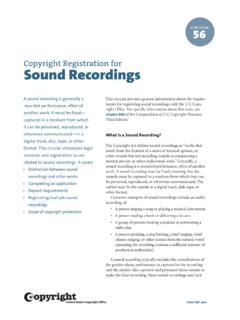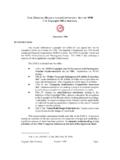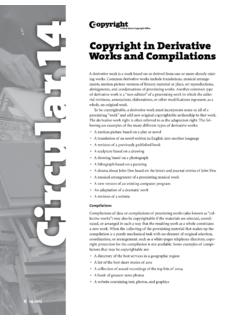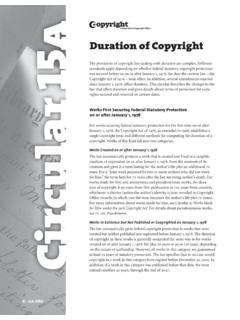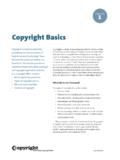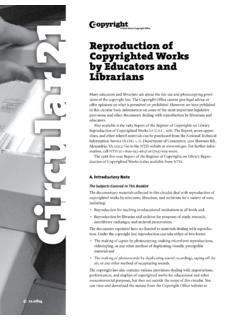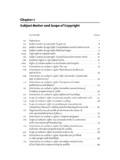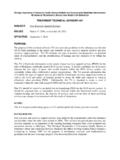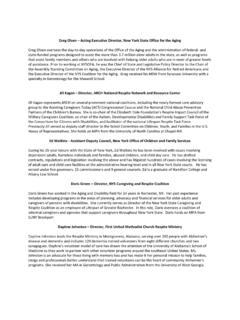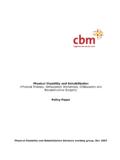Transcription of TITLE I—AMENDMENTS TO THE INDI- VIDUALS …
1 118 STAT. 2647 PUBLIC LAW 108 446 DEC. 3, 2004 Public Law 108 446108th CongressAn ActTo reauthorize the individuals with disabilities education Act, and for other it enacted by the Senate and House of Representatives ofthe United States of America in Congress assembled,SECTION 1. SHORT Act may be cited as the individuals with DisabilitiesEducation Improvement Act of 2004 .SEC. 2. ORGANIZATION OF THE Act is organized into the following titles: TITLE I Amendments to the individuals with DisabilitiesEducation II National Center for Special education III Miscellaneous I AMENDMENTS TO THE INDI- VIDUALS with disabilities EDU-CATION ACTSEC. 101. AMENDMENTS TO THE individuals with disabilities EDU-CATION A through D of the individuals with disabilities Edu-cation Act (20 1400 et seq.)
2 Are amended to read as follows: PART A GENERAL PROVISIONS SEC. 601. SHORT TITLE ; TABLE OF CONTENTS; FINDINGS; PURPOSES. (a) SHORTTITLE. This TITLE may be cited as the Individualswith disabilities education Act . (b) TABLE OFCONTENTS. The table of contents for this titleis as follows: PARTA GENERALPROVISIONS Sec. 601. Short TITLE ; table of contents; findings; purposes. Sec. 602. Definitions. Sec. 603. Office of Special education Programs. Sec. 604. Abrogation of State sovereign immunity. Sec. 605. Acquisition of equipment; construction or alteration of facilities. Sec. 606. Employment of individuals with disabilities . Sec. 607. Requirements for prescribing regulations. Sec.
3 608. State administration. Sec. 609. Paperwork reduction. Sec. 610. Freely associated USC withDisabilitiesEducationImprovement Actof USC 3, 2004[ 1350]VerDate 11-MAY-2000 12:14 Jan 11, 2005 Jkt 039139 PO 00446 Frm 00001 Fmt 6580 Sfmt 6582 E:\PUBLAW\ APPS06 PsN: PUBL446118 STAT. 2648 PUBLIC LAW 108 446 DEC. 3, 2004 PARTB ASSISTANCE FOREDUCATION OFALLCHILDRENWITHDISABILITIES Sec. 611. Authorization; allotment; use of funds; authorization of appropria-tions. Sec. 612. State eligibility. Sec. 613. Local educational agency eligibility. Sec. 614. Evaluations, eligibility determinations, individualized education pro-grams, and educational placements. Sec. 615. Procedural safeguards.
4 Sec. 616. Monitoring, technical assistance, and enforcement. Sec. 617. Administration. Sec. 618. Program information. Sec. 619. Preschool grants. PARTC INFANTS ANDTODDLERSWITHDISABILITIES Sec. 631. Findings and policy. Sec. 632. Definitions. Sec. 633. General authority. Sec. 634. Eligibility. Sec. 635. Requirements for statewide system. Sec. 636. Individualized family service plan. Sec. 637. State application and assurances. Sec. 638. Uses of funds. Sec. 639. Procedural safeguards. Sec. 640. Payor of last resort. Sec. 641. State interagency coordinating council. Sec. 642. Federal administration. Sec. 643. Allocation of funds. Sec. 644. Authorization of appropriations. PARTD NATIONALACTIVITIESTOIMPROVEEDUCATION OFCHILDRENWITHDISABILITIES Sec.
5 650. Findings. SUBPART1 STATE PERSONNEL DEVELOPMENT GRANTS Sec. 651. Purpose; definition of personnel; program authority. Sec. 652. Eligibility and collaborative process. Sec. 653. Applications. Sec. 654. Use of funds. Sec. 655. Authorization of appropriations. SUBPART2 PERSONNEL PREPARATION, TECHNICAL ASSISTANCE, MODELDEMONSTRATION PROJECTS, AND DISSEMINATION OF INFORMATION Sec. 661. Purpose; definition of eligible entity. Sec. 662. Personnel development to improve services and results for childrenwith disabilities . Sec. 663. Technical assistance, demonstration projects, dissemination of infor-mation, and implementation of scientifically based research. Sec. 664. Studies and evaluations.
6 Sec. 665. Interim alternative educational settings, behavioral supports, andsystemic school interventions. Sec. 667. Authorization of appropriations. SUBPART3 SUPPORTS TO IMPROVE RESULTS FOR CHILDREN with disabilities Sec. 670. Purposes. Sec. 671. Parent training and information centers. Sec. 672. Community parent resource centers. Sec. 673. Technical assistance for parent training and information centers. Sec. 674. Technology development, demonstration, and utilization; and mediaservices. Sec. 675. Authorization of appropriations. SUBPART4 GENERAL PROVISIONS Sec. 681. Comprehensive plan for subparts 2 and 3. Sec. 682. Administrative provisions. (c) FINDINGS. Congress finds the following: (1) Disability is a natural part of the human experienceand in no way diminishes the right of individuals to participatein or contribute to society.
7 Improving educational results forchildren with disabilities is an essential element of our nationalVerDate 11-MAY-2000 12:14 Jan 11, 2005 Jkt 039139 PO 00446 Frm 00002 Fmt 6580 Sfmt 6581 E:\PUBLAW\ APPS06 PsN: PUBL446118 STAT. 2649 PUBLIC LAW 108 446 DEC. 3, 2004policy of ensuring equality of opportunity, full participation,independent living, and economic self-sufficiency for individualswith disabilities . (2) Before the date of enactment of the education forAll Handicapped Children Act of 1975 (Public Law 94 142),the educational needs of millions of children with disabilitieswere not being fully met because (A) the children did not receive appropriate edu-cational services; (B) the children were excluded entirely from the publicschool system and from being educated with their peers; (C) undiagnosed disabilities prevented the childrenfrom having a successful educational experience; or (D) a lack of adequate resources within the publicschool system forced families to find services outside thepublic school system.
8 (3) Since the enactment and implementation of the Edu-cation for All Handicapped Children Act of 1975, this titlehas been successful in ensuring children with disabilities andthe families of such children access to a free appropriate publiceducation and in improving educational results for childrenwith disabilities . (4) However, the implementation of this TITLE has beenimpeded by low expectations, and an insufficient focus onapplying replicable research on proven methods of teachingand learning for children with disabilities . (5) Almost 30 years of research and experience has dem-onstrated that the education of children with disabilities canbe made more effective by (A) having high expectations for such children andensuring their access to the general education curriculumin the regular classroom, to the maximum extent possible,in order to (i) meet developmental goals and, to the max-imum extent possible, the challenging expectationsthat have been established for all children; and (ii) be prepared to lead productive and inde-pendent adult lives, to the maximum extent possible.
9 (B) strengthening the role and responsibility of par-ents and ensuring that families of such children have mean-ingful opportunities to participate in the education of theirchildren at school and at home; (C) coordinating this TITLE with other local, educationalservice agency, State, and Federal school improvementefforts, including improvement efforts under theElementary and Secondary education Act of 1965, in orderto ensure that such children benefit from such efforts andthat special education can become a service for such chil-dren rather than a place where such children are sent; (D) providing appropriate special education andrelated services, and aids and supports in the regular class-room, to such children, whenever appropriate; (E) supporting high-quality, intensive preservicepreparation and professional development for all personnelwho work with children with disabilities in order to ensurethat such personnel have the skills and knowledge nec-essary to improve the academic achievement and functionalVerDate 11-MAY-2000 12:14 Jan 11, 2005 Jkt 039139 PO 00446 Frm 00003 Fmt 6580 Sfmt 6581 E:\PUBLAW\ APPS06 PsN: PUBL446118 STAT.
10 2650 PUBLIC LAW 108 446 DEC. 3, 2004performance of children with disabilities , including the useof scientifically based instructional practices, to the max-imum extent possible; (F) providing incentives for whole-school approaches,scientifically based early reading programs, positive behav-ioral interventions and supports, and early interveningservices to reduce the need to label children as disabledin order to address the learning and behavioral needs ofsuch children; (G) focusing resources on teaching and learning whilereducing paperwork and requirements that do not assistin improving educational results; and (H) supporting the development and use of technology,including assistive technology devices and assistive tech-nology services, to maximize accessibility for children withdisabilities.
